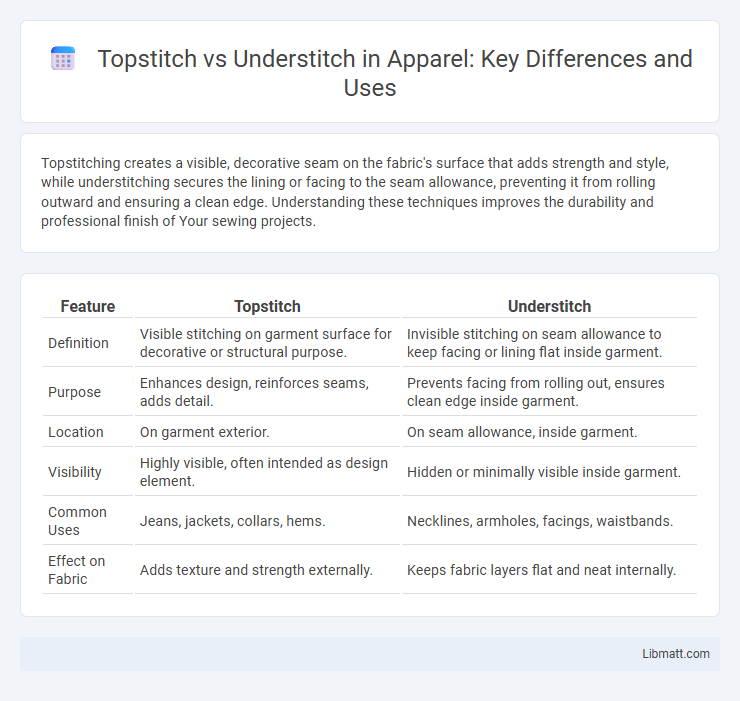Topstitching creates a visible, decorative seam on the fabric's surface that adds strength and style, while understitching secures the lining or facing to the seam allowance, preventing it from rolling outward and ensuring a clean edge. Understanding these techniques improves the durability and professional finish of Your sewing projects.
Table of Comparison
| Feature | Topstitch | Understitch |
|---|---|---|
| Definition | Visible stitching on garment surface for decorative or structural purpose. | Invisible stitching on seam allowance to keep facing or lining flat inside garment. |
| Purpose | Enhances design, reinforces seams, adds detail. | Prevents facing from rolling out, ensures clean edge inside garment. |
| Location | On garment exterior. | On seam allowance, inside garment. |
| Visibility | Highly visible, often intended as design element. | Hidden or minimally visible inside garment. |
| Common Uses | Jeans, jackets, collars, hems. | Necklines, armholes, facings, waistbands. |
| Effect on Fabric | Adds texture and strength externally. | Keeps fabric layers flat and neat internally. |
Introduction to Topstitch and Understitch
Topstitch is a sewing technique where stitches are visible on the right side of the fabric, providing both decorative and functional reinforcement. Understitch involves sewing the seam allowance to the facing or lining to prevent the fabric from rolling to the outside, enhancing the garment's finish and fit. Both techniques are essential for garment construction, with topstitch focusing on aesthetics and durability, while understitch ensures a clean inner seam appearance.
What is Topstitching?
Topstitching is a decorative and functional sewing technique where stitches are sewn on the right side of the fabric, often visible, to reinforce seams or add design details. It helps to keep seam allowances flat and prevent them from rolling to the fabric's front, enhancing durability and appearance. Your projects benefit from topstitching by achieving a polished finish and added strength along edges and seams.
What is Understitching?
Understitching is a sewing technique used to keep seam allowances flat and prevent the lining from rolling to the outside of a garment. It involves stitching the seam allowance to the facing or lining, close to the seam line, ensuring crisp edges and a professional finish. This method improves garment structure by maintaining clean interior lines and enhancing overall durability.
Key Differences Between Topstitch and Understitch
Topstitch involves sewing a visible line of stitching on the fabric's right side to add decorative detail and reinforce seams, commonly used on necklines, hems, and pockets. Understitch is stitched on the seam allowance side close to the seam line to keep the facing or lining from rolling to the outside, ensuring a clean edge and improved garment shape. The primary difference lies in their function and placement: topstitch is decorative and structural on the garment's exterior, while understitch is functional and hidden within the seam allowances.
Purposes and Functions of Topstitching
Topstitching serves the purpose of reinforcing seams, providing durability and enhancing the garment's structural integrity. It functions as a decorative element, offering visible, precise stitching that adds visual interest and polished finish to clothing edges and hems. Unlike understitching, which hides seam allowances to prevent fabric from rolling, topstitching emphasizes strength and aesthetic appeal on the garment's exterior.
Purposes and Functions of Understitching
Understitching is a sewing technique primarily used to keep the facing or lining from rolling to the outside of a garment, creating a clean and professional finish along seams. It secures the seam allowance to the facing or lining close to the seam line, enhancing comfort by preventing bulky edges against the skin. Unlike topstitching, which is visible and decorative, understitching is discreet and focuses on maintaining garment structure and appearance.
When to Use Topstitch vs Understitch
Topstitch is ideal for creating a visible, decorative seam on the outside of garments, providing durability on edges like collars, hems, and pockets. Understitch is best used inside seams to keep facings or linings from rolling to the outside, ensuring a clean, professional finish without visible stitching on the garment's surface. Use topstitch when you want a strong, stylish seam on exterior fabric, and select understitch to secure inner seam allowances discreetly.
Techniques and Tools for Topstitching
Topstitching involves sewing visible stitches on the fabric's surface to provide decorative detail and structural reinforcement, typically executed using a standard sewing machine with a topstitch needle, heavier thread, and a straight stitch setting. Tools such as a quilting or edge-stitch foot help maintain precise seam allowance and consistent stitch length, critical for achieving professional results. Unlike understitching, which hides seams on the inside, topstitching requires careful tension adjustment and fabric stabilization techniques like stay stitching or interfacing to avoid puckering and distortion.
Techniques and Tools for Understitching
Understitching involves sewing the seam allowance to the facing or lining to prevent it from rolling to the outside, typically using a straight stitch close to the seam line with a regular presser foot on a sewing machine. Specialized tools such as a clear or edge-stitch foot enhance precision, ensuring an even distance from the seam and cleaner finish, while a pressing tool or clapper helps set the stitches flat for a professional look. Mastering the understitch technique improves garment structure and comfort, making Your sewing projects appear neater and more polished.
Final Tips for Choosing the Right Stitching Method
Topstitching enhances garment durability and provides a visible, decorative finish, ideal for edges and necklines requiring reinforcement. Understitching, primarily used to keep facings or linings hidden, ensures a clean interior look and prevents fabric from rolling to the outside. Choose topstitch for strength and style, whereas understitch is best when a smooth, polished inside edge is the priority.
Topstitch vs understitch Infographic

 libmatt.com
libmatt.com